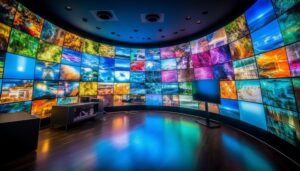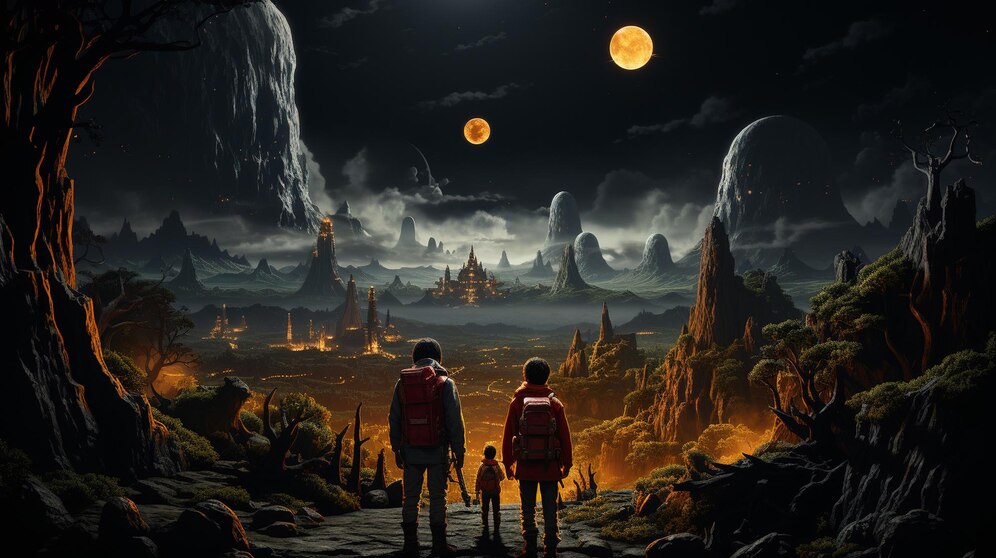The Evolution of Entertainment: From Silent Films to Virtual Reality

Introduction
There’s an old form of entertainment in town, but it’s not without its fair share of revolutionary influences. From humble beginnings in silent films to today’s immersive virtual reality experiences, the journey of entertainment has been a mesmerizing ride. Full of perfect symphonies and dramatic climaxes, technology has composed a fascinating narrative that resonates with every love for amusement.
Definition of Entertainment
Entertainment is an activity that provides enjoyment and amusement, stirring our emotions and captivating our senses. It can range from cinematic adventures, including silent films and cinematic blockbusters, to gaming experiences, such as consoles and virtual reality.
Importance of Entertainment in Human Society
Entertainment plays a vital part in our society:
– It delivers relaxation and a mental escape.
– It fosters social connection and active conversations.
– It helps educate and inspire.
– And ultimately, it recreates worlds that fill our lives with joy and wonder.
The Era of Silent Films

Introduction to Silent Films
Our journey through the evolution of entertainment kicks off with silent films. These cinematic masterpieces, completely devoid of synced audio, showcased moving pictures that conveyed a story, often with the assistance of live piano or orchestra and on-screen text to help depict dialogue or narrate the plot. Notably, the era of silent films lasted from the 1890s up until the late 1920s.
Early Pioneers and Iconic Silent Film Actors
The silent film era gifted us with remarkable talents and pioneers who laid the foundation for modern cinema. Iconic figures, like Charlie Chaplin, Buster Keaton, and Mary Pickford, took the film industry by storm with their expressive performances and comedic timing.
• Charlie Chaplin became a global icon through his silent film character “The Tramp.”
• Buster Keaton, renowned for his physical comedy stunts, was a master of both subtlety and slapstick.
• Often referred to as “America’s Sweetheart,” Mary Pickford became one of the most popular actresses and producers of her time.
The Impact of Silent Films on Society
Silent films played an undeniable role in shaping society’s view of entertainment. They propelled the popularity of cinema-going, established the foundation for cinematic narrative technique, and most importantly, made storytelling a universal language that transcended borders and language barriers, marking the beginnings of global popular culture.
The Birth of Sound in Film

The journey of sound in films quite literally echoed the evolution of entertainment. It fundamentally transformed movies, shaping them into the multimedia spectacles we enjoy today.
The Invention of Sound Technology in Film
The onset of the 1920s saw the introduction of sound in films, spearheaded by the ingenious use of technology. The “sound-on-film” technique was conceived, involving the transformation of sound into light and then back into sound. This innovation was nothing short of revolutionary, mending the silent gap that existed in motion pictures since their invention.
Transition from Silent to Sound Films
The switch from silent films to sound-on-film wasn’t instant. The transition was gradual, stirring both excitement and skepticism among viewers and within the film industry. Initially, silent film stars had to adapt to this new format, some found it challenging, while others thrived.
• “The Jazz Singer” (1927) was the first “talkie,” a blend of silent scenes, synchronized music, and dialogue.
• By the 1930s, “talkies” dominated, and silent films dwindled into relative obscurity.
Popular Sound Films and their Impact on the Entertainment Industry
Sound films had an enormous influence on the entertainment industry. Masterpieces like “Gone with the Wind”, “Casablanca” and “The Wizard of Oz” wouldn’t exist in their beloved forms without this technology. These films grabbed people’s attention, bedazzled audiences with dialogue, and accentuated the emotional impact of scenes through music and sound effects. Thus, creating a more immersive entertainment experience.
The Golden Age of Hollywood

It was a period marked by innovation, glamour, and a flourishing of talent that Hollywood had never experienced before. We’re talking about the so-called ‘Golden Age of Hollywood’, a period roughly from the late 1920s to the early 1960s. This era is recognized for its feature-length, multi-reel films that began following the advent of sound in film.
Introduction to the Golden Age of Hollywood
The Golden Age of Hollywood was characterized by cinematic innovation and monumental changes in the industry. As silent films faded into oblivity, sound films, known popularly as ‘the talkies’, completely transformed the cinematic experience. Impressive technological innovations came to prominence, including massive, bold Technicolor films that took the audience’s breathe away.
Iconic Actors and Actresses
– Clark Gable
– Vivien Leigh
– Humphrey Bogart
– Ingrid Bergman
– Marilyn Monroe
These are just a few of the many influential actors who rose to prominence in this period, stealing hearts and redefining the meaning of star power in Hollywood.
Major Film Genres of the Time
At this time, the variety and breadth of film genres increased significantly. Major genres include:
– Epic dramas like ‘Gone with the Wind’
– Quirky comedies like ‘Some Like It Hot’
– Suspenseful noir films like ‘The Maltese Falcon’
– Moving musicals like ‘Singin’ in the Rain’
These genres continued to influence film making styles and techniques far beyond the Golden Age, each leaving a lasting legacy on the canvas of Hollywood.
The Rise of Television

With the invention of the television in the 1920s, the world of entertainment witnessed a new dawn. However, television sets didn’t become commercially available until the late 1940s. Brightly lit screens beaming moving images into the comfort of our homes promised an immersive visual experience.
Introduction to Television
Televisions brought about a different kind of magic. Suddenly, news broadcasts, sitcoms, and game shows came alive in living rooms around the world with incredible accessibility. Popular favorites like “I Love Lucy” and “The Ed Sullivan Show” captured the hearts of millions on their small screens.
Early Television Shows and Cultural Impact
It wasn’t just about entertainment; television quickly became a cultural phenomenon influencing societal norms and perceptions. For example, everything from dress codes to speech patterns was heavily influenced by characters from our favorite TV shows.
• “The Honeymooners” and “Leave It to Beaver” set standard for family values and dynamics.
• “Star Trek”, though a sci-fi series, opened dialogues on issues of racial equality and inclusiveness.
Competition Between Film and Television
As television gained popularity, the film industry faced immense competition. The convenience and accessibility of TVs meant that people no longer needed to venture out to theaters to enjoy a show. This competition spurred innovation, pushing the film industry to constantly raise its game.
The Digital Revolution in Entertainment

The digital revolution marked a significant turning point in the world of entertainment that forever changed how media is created, consumed, and distributed.
Introduction to Digital Technology in Entertainment
Born in the late 20th century, digital technology has drastically shaped our interactions with entertainment. Gone are the days when we had to wait in line to watch a movie at the theater or tune in to a specific channel at a particular time to catch our favorite TV show. Now, we have 24/7 access to media content right at our fingertips, thanks to digital technology.
Transition from Physical Film to Digital Formats
The transition was neither smooth nor sudden. It began subtly in the 80s with the introduction of digital video discs (DVDs) and streamlined in the 2000s with the dominance of internet-based platforms like YouTube and Netflix.
• Analog film reels gave way to digital storage solutions like DVDs and Blu-rays.
• Broadcast television was slowly replaced by streaming services that offer on-demand content.
Impact on Filmmaking and Distribution
The digital era brought about significant changes in both filmmaking and distribution. Movie production became less costly and more accessible, leading to a surge in independent filmmakers. Distribution too experienced a sea change. Media companies now had direct access to their audiences through digital platforms, nullifying the need for traditional distribution channels like theatres or broadcasting networks.
The digital revolution in entertainment has indeed been a game-changer, offering endless possibilities to both creators and consumers.
The Era of Streaming Services

Streaming services have fundamentally reformed how we consume entertainment. Moving on from physically storing films and TV shows to virtually accessible media, online streaming platforms have taken the world by storm.
Introduction to Streaming Services
Stepping from DVD rental shops to viewing content online was a paradigm shift in the entertainment industry. This technological revolution meant entertainment could be accessed anywhere, anytime – a comfort truly appealing to the masses. Streaming platforms are websites or applications that allow users to watch a vast range of programs – films, series, documentaries, and more – seamlessly over the internet, instead of downloading them onto a device.
Popular Streaming Platforms and their Impact on the Entertainment Industry
• Netflix: An undeniable leader in the streaming services industry, Netflix shifted the paradigm of broadcasting with its extensive range of original content.
• Amazon Prime Video: Besides providing a diverse selection of TV shows and movies, Amazon Prime ushered in a new era of live concert and sports streaming.
• Hulu: An exemplary model of collaborative effort by media giants like Disney, NBCUniversal, and Warner Brothers.
This “all-you-can-eat” model of content consumption has disrupted traditional broadcasting, launching an era of binge-watching.
Challenges Faced by Traditional Film and TV Studios
Streaming services’ ascendancy has meant challenges for traditional film and TV studios. With audience attention shifting to digital platforms, these traditional mediums have had to rethink their strategies. Struggling to match the convenience, diversity, and original content offered by streaming platforms, they’re fighting to remain relevant in this digital era.
Virtual Reality: The Next Frontier

Virtual reality (VR) is changing our world, especially in the domain of entertainment. Let’s journey into this realm!
Introduction to Virtual Reality Technology
Virtual reality is a fascinating form of entertainment tech that simulates a user’s physical presence in a simulated environment. This technology tricks your brain into believing you are in a digitally constructed world, thanks to the VR headsets that primarily facilitate the experience. A significant influence on the evolution of VR has been its focus on full immersion, placing you right in the middle of the action rather than making you a mere observer.
Applications of Virtual Reality in the Entertainment Industry
The applications of VR tech are wide and intriguing:
– **Gaming:** The gaming industry has indeed embraced VR, delivering thrilling and immersive experiences.
– **Movies:** Some filmmakers are now using VR to put their audience right in the middle of the action.
– **Theme Parks:** Certain attractions and rides are designed using VR, making for far more exciting experiences.
Potential Future Development of Virtual Reality Entertainment
The future of entertainment is undoubtedly bound with VR technology. As VR headsets become more affordable and accessible, we expect VR will grow beyond gaming and movies, possibly expanding into concerts, theater performances, and other live events. Imagine enjoying live concerts from around the world right from your living room! The evolution of entertainment is an exciting journey, and we can’t wait to see where VR takes it next.
Conclusion
Summary of the evolution of entertainment
From the black and white world of silent pictures to the immersive universe of virtual reality, the evolution of entertainment has been nothing short of spectacular. We’ve seen:
– Silent films morphing into sound films, paving the way for a new era of ‘Talkies.’
– Television revolutionizing the reach of entertainment straight into our homes.
– Gaming consoles and online gaming adding a fun and interactive element to entertainment.
– The advent of internet and streaming services making entertainment on-demand and accessible to all.
– And finally, virtual reality taking the entertainment experience to a whole new level of immersion.
Reflection on the impact of technology on entertainment experiences
Technology has truly transformed the entertainment landscape, making experiences more real, immersive, and personal. Movies, music, gaming – technology has elevated every facet of entertainment, making it an integral part of our everyday life.
The future of entertainment and its relationship with technology
Looking ahead, technology appears to play an even more prominent role in spiralling the evolution of entertainment. As we see it, Augmented Reality (AR), Artificial Intelligence (AI), and Machine Learning are ready to take the driver’s seat. These advances promise to create personalized and immersive experiences that we can’t even imagine yet, making the line between reality and digital entertainment even more blurred. As we continue to make giant leaps in technology, one can only wait with bated breath to see what’s next in the exciting world of entertainment.
https://www.wolfywide.com/the-evolution-of-entertainment-from-silent-films-to-virtual-reality
Follow Us For More




